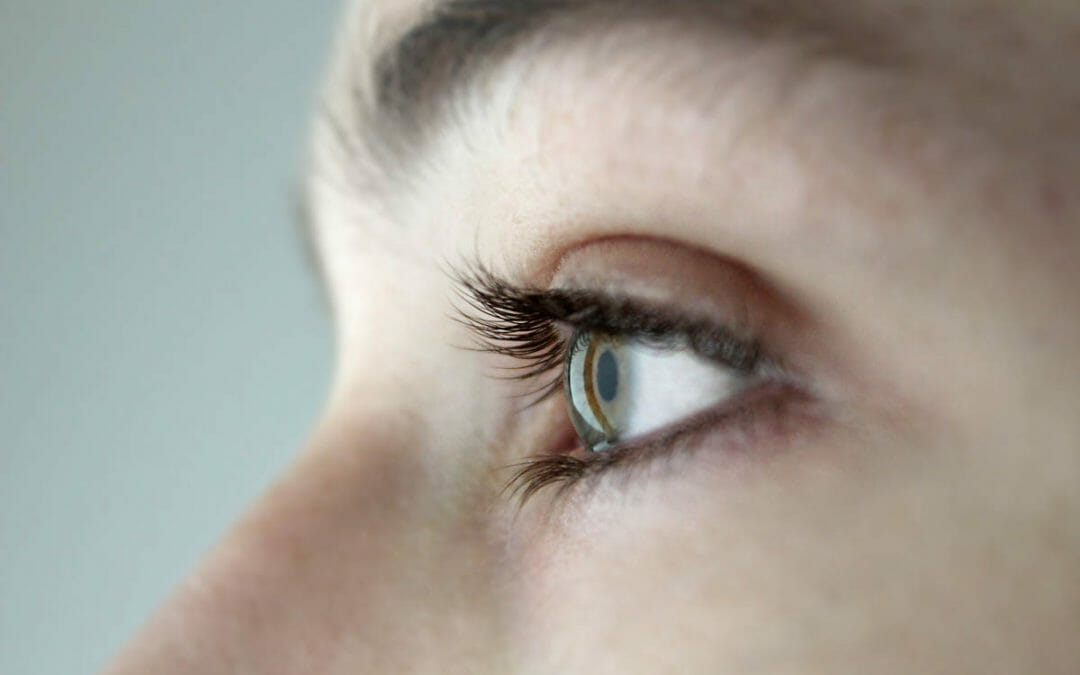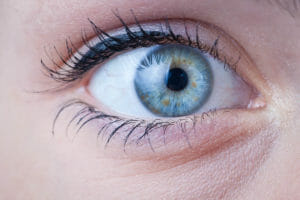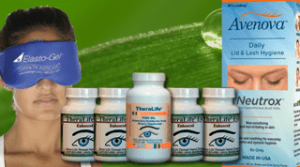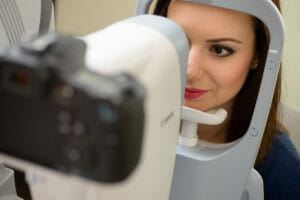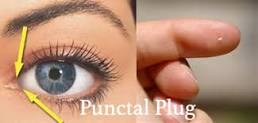How to cured my dry eyes permanently?
Do you have eye irritation and wish you could get rid of it once and for all?
There is no permanent cure for this health condition – dry eye syndrome. However, dry eye treatments can help you maintain moisture in the eyes, reduce dry eye symptoms and protect vision.
Currently, there is no permanent cure for dry eye. Still, there are several options to manage and reduce the dry eye symptoms to prevent cornea damage and improve the quality of your life. It is a manageable health condition.
Testimonial – How I cure my dry eyes permanently
Chronic Severe Dry Eyes:
Your TheraLife Eye products are the answers to my prayers for relief of the chronic dry eyes I have suffered for so long. I have tried every lubricating eye drop, punctal plugs, Restasis, etc., with no help.
What made it worse was that I was told by some of the conventional eye doctors that there is no specific cure or relief for dry eyes. This statement gave me more challenge to seek another alternative way of healing, and I thank God that I found your website. You have saved my eyes, my self-esteem, and my self-worth.
I cannot thank you enough for these amazing products you have formulated—my heartfelt thanks and gratitude from the bottom of my heart.
E.B. Clarksville, TN
- Results may vary
How can TheraLife help?
TheraLIfe is an oral dry eye treatment that restores and revives your tear production. Theralite works when drops don’t.
TheraLife Eye capsule is a patented formula packed with vitamins and minerals plus proprietary herbal extracts that promote blood flow and healing throughout the body.
Why TheraLife Works – Natural Dry Eye Relief
TheraLife addresses the source of the problem. Our all-natural supplements for chronic dry eye relief address the fundamental cause of painful, inflamed, and dry eyes: underactive tear secretion.
Only TheraLife® targets this issue intra-cellularly to restore balance and end the cycle of dry, itchy red eyes. TheraLife® promotes your cellular functioning to provide natural dry eye relief with your own body’s healing tears.
After treatment with TheraLife®, you will have an innate ability to make tears, eliminating inflammation and dryness. End your reliance on eye drops and restore your comfortable vision.
Whether you suffer from watery, dry eyes, Blepharitis, meibomian gland dysfunction, chronic and severe dry eyes, or Sjogren’s dry eye/dry mouth symptoms, TheraLife® can end pain and help you get your life back.
Don’t waste time with treatments that don’t work or that fail to address the root cause of your problem. Get TheraLife® today!
Which TheraLife Products Can Help You
Theralife products are all-natural, and no animal products are involved.
Theralite has protocols for complete recovery: click here for the protocol.
To learn more about how it works, click here.
What is dry eye syndrome?
Dry eye syndrome is a common condition where the eyes cannot produce tears, causing eyelid inflammation. Eye irritation is persistent – eye drops don’t help.
Eyelids become infected (Blepharitis), and oil glands clogged (MGD). Clogged oil glands can cause the eyes to feel irritated and result in dry eye symptoms such as blurry vision, foreign body sensation, red eyes, headaches, and even watery eyes.
Who is at risk for dry eyes?
Dry eye is more common in older adults. It affects roughly 5 million people aged 50 years and older in the United States. Over 3.2 million are females, and 1.68 million are males.
However, it can occur at any age. There are nearly 16 million U.S. individuals who have dry eyes.
What causes dry eyes?
Factors that contribute to dry eye include tears evaporating too quickly, not producing enough tears, eyelid problems, the use of medications, and some environmental factors.
The most common dry eye treatment is to use eye drops or another medication to keep the eyes moist.
Dry eye disease occurs when the tear film is no longer in balance because the body does not produce enough tears or if one of the tear layers does not work or spread out properly.
This article will discuss the causes and symptoms of dry eye disease (DED) and how people can manage medication and natural alternatives.
What is Dry Eye Disease (DED)?
DED, also known as dry eye syndrome or keratoconjunctivitis sicca, occurs when the eyes do not stay moist due to problems with the tears. Tear problems can result in the eyes becoming drier, leading to discomfort and problems with vision.
DED is the result of the tear film not working correctly.
Composition of the tear film
The tear film protects and lubricates the surface of the eye and is vital for good vision. It has three layers:
- Outer layer: This layer is oily, reduces tear evaporation at the eye surface, and helps spread the tear film across the eye surface.
- Middle layer: This watery layer is a significant constituent of tears. It helps wash away foreign objects such as grit.
- Inner layer: This sticky layer (Mucin) coats the cornea and helps spread the watery layer. It also helps keep the tear film stuck to the surface of the eye.
Blinking spreads tears across the eyes, which then drain into the nose. Several glands and systems keep the tear film in its optimal state.
Is there a cure for dry eyes permanently?
Currently, there is no permanent cure for dry eye disease.
However, several options can help you reduce symptoms and protect your vision.
Dry eye treatments focus on removing or minimizing environmental triggers and maintaining an adequate and functional tear film on the eye’s surface.
If there is a simple underlying cause for your DED, your eye doctor can quickly treat and resolve the symptoms. However, most chronic dry eye diseases are more complicated.
Dry eye symptoms
Dry eye symptoms can include:
- a stinging or burning feeling in the eyes
- a sense of pressure in the eyes, or a feeling that something is in them
- redness
- blurred vision or sensitivity to light
- difficulty or discomfort when opening the eyes
- The crusty sticky build-up, and swollen red eyelids indicate eyelid inflammation called Blepharitis.
- Swollen red eyelids, clogging on meibomian oil glands called Meibomian Gland Dysfunction.
Types of Dry Eyes
Evaporative dry eyes – Tear quantity – not enough tears or tear not thick enough – quality is poor.
Menopause: Females are more likely to have DED because of hormonal changes affecting tear production. There is the hormone in tears.
Aging. Bodies tend to make fewer tears as they age, so DED is more common in older adults.
Autoimmune diseases: such as Sjogren’s, rheumatoid arthritis, Lupus, Ocular Rosacea, Parkinson’s disease, thyroid disease
Vitamin A deficiency: High doses of Vit. A can be toxic. Thus we use beta-carotene, which converts into Vit.A in your bloodstream. Beta-carotene is a safer alternative that works.
Birth Control – Birth control might cause eye-related side effects, including dry eye and eye discomfort.
Risk Factors
Some other risk factors or common causes of DED may include:
- some skin conditions on or near the eyelids, e.g., excema
- deficiency in vitamin A or omega-3 fatty acids
- LASIK eye surgery
- wearing contact lenses. Contact lenses provide a surface for tears to evaporate, making dry eyes worse.
- Computer screen- spending a long time looking at the computer screen will reduce blinking, making dry eyes worse.
- allergies that affect the eyes
- eye makeup, especially mascara.
- some long-term conditions, such as diabetes and Sjögren’s disease
- the gland (meibomian oil glands located on the eyelids) that produces the oily layer not operating properly
- environmental factors such as smoke, wind, or dry air
- some medications, including treatments for depression and blood pressure medications.
- Watery eyes – caused either by blocked tear ducts or chronic dry eyes.
Diagnosis
Dry eyes can be diagnosed through a comprehensive eye examination. Testing with emphasis on the evaluation of the quantity and quality of tears produced by the eyes may include:
- Patient history to determine the patient’s symptoms and to note any general health problems, medications or environmental factors that may be contributing to the dry eye problem.
- External examination of the eye, including lid structure and blink dynamics.
- Evaluation of the eyelids and cornea using bright light and magnification.
- Measurement of the quantity and quality of tears for any abnormalities. Special dyes may be put in the eyes to observe tear flow and highlight any changes to the eye’s outer surface caused by insufficient tears.
With the information obtained from testing, a doctor of optometry can determine if you have dry eyes and advise you on treatment options.
Types of Tests for Dry Eyes
It is crucial to find out the underlying cause of your eye condition. An eye doctor can check for your eye conditions as a part of a comprehensive eye exam and provide medical advice.
This examination may involve the doctor administering eye drops and checking eye health.
The exam could be one of the following:
- Slit-lamp test: The doctor will use a microscope plus fluorescent dye to see if the eyes produce enough tears.
- Schirmer’s test: The doctor will use a small piece of paper to measure the amount of tears.
- Tear breakup time: The doctor will use this test to check the viscosity of your tear and see how long the tear film remains after a person blinks.
Treatment options
Get the best medical advice from your healthcare professional for medical advice.
Some of the most common dry eye treatments are:
- Artificial tears solution: Artificial tears are common. Artificial tears are the most common dry eye treatment, and doctors will usually recommend them first. People can buy over the counter without a prescription. Note side effects of frequent use of artificial tears make your eyes drier.
- Blood serum drops – there are eye drops made from your blood cells.
- Moisturizing gels or ointments: Instead of artificial tears, a doctor may suggest over-the-counter gels or ointments to help the eyes feel better. Gels are beneficial for people who have nighttime dry eyes.
- Eye inserts – Lacrisert to provide lubrication.
- Eye masks help trap moisture in the eyes and keep eyelids closed at night. Some people have dry eyes at night because their eyelids are partially open.
- Prescription eye drops: In more severe cases, a doctor may prescribe cyclosporine (Restasis, Cequa) or lifitegrast (Xiidra) eye drops to help reduce inflammation and increase tear production. The sides effects of prescription eye drops can be red, irritated eyes.
- Tear duct surgery to enhance tear drainage for watery eyes.
- Essential fatty acids: such as Omega 3 fatty acids. The animal product fish oil has the best source. Otherwise, Flaxseed oil will also work.
- Punctal plugs: Punctal plugs are special plugs that go in the openings of the tear ducts, called puncta. Punctal plugs can relieve dry eyes by shoring up tears in the eye to stay longer- providing you are making enough tears.
- Surgery: In rare cases, a doctor may suggest surgery to tighten the lower eyelids and help the eyes retain tears.
- Lifestyle changes: More exercise, avoid caffeine, sugar, and alcohol, and eat more vegetables and less meat. Reduce inflammation through diets.
- Changing medication: If a person is taking for another health condition that is causing dry eye, a doctor may suggest changing to a different medication.
- Treatment for Blepharitis and MGD – many eye doctors recommend baby shampoo to clean eyelids and warm compress. Baby shampoo has proven not to work. We recommend Avenova eyelid cleanser.
- Intense Pulsed Light therapy for dry eyes – light therapy especially for clogged meibomian glands (MGD). This light therapy also treats facial rosacea. Another light therapy for meibomian glands is LipiFlow.
Home remedies for dry eyes
You can help your dry eye conditions by doing some of the following.
These include:
- soothing inflamed eyelids with warm compresses, eyelid massages, or eyelid cleaners
- getting enough sleep
- drinking plenty of water- eight glasses of water per day
- using a humidifier- especially in your bedroom at night
- avoiding smoke, wind, air conditioning, and dry environments.
- wearing wraparound sunglasses while outdoors
- reducing screen use, taking breaks, and blinking frequently
- consuming more vitamin A and omega-3’s through one’s diet or by taking supplements
- Eat enough leafy greens, and reduce intake of red meat.
Visit your healthcare professional for a regular check-up to ensure eye health.
Diet for dry eyes
Yes, some foods are good for overall health and improve the quality of tears and eye comfort.
Omega fatty acids
Suppose the outer layer of the lubricating tear film is disrupted. In that case, it leads to dry eye symptoms like redness, itchiness, and burning.
Omega fatty acids are responsible for stabilizing the oil layer in the tear film, making them essential for lubricating your eyes.
In addition, omega fatty acids have an anti-inflammatory effect, so both Omega-3 and omega-6 fatty acids are essential nutrients.
Foods high in omega fatty acids include:
- Fish: mackerel, cod, trout, herring, salmon
- Oils: canola oil, rapeseed oil, flaxseed oil, sunflower oil, walnut oil
- Meat: pork, beef, and lamb
- Dairy: cheese and milk products
Vitamins
Several vitamins also can help boost general eye health and dry eye.
Vitamin A (retinol)
Vitamin A deficiency, which usually occurs in developing countries, can cause an increase in dry eye. Adding foods rich in Vitamin A like pumpkins, apricots, carrots, tomatoes, spinach, dairy products, and liver can help. It also helps protect the surface of the eye.
Vitamin B2
Vitamin B2 exists in avocados, broccoli, whole-grain, and dairy products. It also protects the eyes from cell damage.
Vitamin B6
Vitamin B6 is in foods such as goose, potatoes, kale, salmon, mackerel, and sardines. Vitamin B6 gives a functioning tear film.
Vitamin B12
Foods that contain Vitamin B12 are beef liver, calf’s liver, pork liver, and mackerel. Dairy products and eggs have small amounts. It is also essential for lubricating the eye.
Vitamin C
Vitamin C contains broccoli, rosehip, acerola berries, peppers, and Brussels sprouts. It protects against oxidative stress and plays an essential role in maintaining a functioning tear film.
Vitamin E
Mackerel, wheat germ oil, sunflower oil, spinach, peppers, mangos, and red currants contain Vitamin E. It is required to protect your eyes against cell damage and dry eyes.
Lutein and Zeaxanthin
Lutein and zeaxanthin are antioxidants that help prevent many chronic eye diseases, including dry eye. They also keep cells functioning correctly and healthy. Foods rich in these antioxidants include leafy greens like kale, spinach, and romaine lettuce. They are also supplements.
Zinc
Zinc plays an essential role in keeping eyes healthy. Zinc is responsible for transporting vitamin A from the liver to the retina. It also produces melanin, a pigment that protects your eyes. Zinc is in whole grains, dairy, sweet corn, peas, lentils, and nuts.
Drinking-Water Hydrates Your Eyes
While water is not a vitamin, drinking water is vital for the eyes. Staying hydrated can help improve eye comfort. Water is excellent for your skin, kidneys, bowels, and eyes.
Staying hydrated and eating healthy helps ensure that your eyes get the minerals and vitamins.
How can TheraLife help?
TheraLIfe is an oral dry eye treatment that restores and revives your tear production. Theralite works when drops don’t.
TheraLife Eye capsule is a patented formula packed with vitamins and minerals plus proprietary herbal extracts that promote blood flow and healing throughout the body.
Why TheraLife Works – Natural Dry Eye Relief
TheraLife addresses the source of the problem. Our all-natural supplements for chronic dry eye relief address the fundamental cause of painful, inflamed, and dry eyes: underactive tear secretion.
Only TheraLife® targets this issue intra-cellularly to restore balance and end the cycle of dry, itchy red eyes. TheraLife® promotes your cellular functioning to provide natural dry eye relief with your own body’s healing tears.
After treatment with TheraLife®, you will have an innate ability to make tears, eliminating inflammation and dryness. End your reliance on eye drops and restore your comfortable vision.
Whether you suffer from watery, dry eyes, Blepharitis, meibomian gland dysfunction, chronic and severe dry eyes, or Sjogren’s dry eye/dry mouth symptoms, TheraLife® can end pain and help you get your life back.
Don’t waste time with treatments that don’t work or that fail to address the root cause of your problem. Get TheraLife® today!
Which TheraLife Products Can Help You
Theralife products are all-natural, and no animal products are involved.
Theralite has protocols for complete recovery: click here for the protocol.
To learn more about how it works, click here.
Other health information resources.
TFOS dew ii report: https://www.tearfilm.org/public/TFOSDEWSII-Executive.pdf
TFOS dew ii report on : https://www.tearfilm.org/dettnews- tfos_dews_ii_patient_summary/6814_5519/eng/
American Optometric Association: https://www.aoa.org/news/clinical-eye-care/diseases-and-conditions/winter-dry-eye?sso=y
https://en.wikipedia.org/wiki/Rolando_Toyos
References
- Stapleton F, Alves M, Bunya VY, et al. : TFOS DEWS II Epidemiology Report. Ocul Surf.2017;15(3):334–65. 10.1016/j.jtos.2017.05.003
- Blehm C, Vishnu S, Khattak A, et al. : Computer vision syndrome: a review. Surv Ophthalmol.2005;50(3):253–62. 10.1016
- Tsubota K, Nakamori K: Dry eyes and video display terminals. N Engl J Med.1993;328(8):584. 10.1056/NEJM
- Uchino M, Dogru M, Uchino Y, et al. : Japan Ministry of Health study on prevalence of dry eye disease among Japanese high school students. Am J Ophthalmol.2008;146(6):925–
- Zhang Y, Chen H, Wu X: Prevalence and risk factors associated with dry eye syndrome among senior high school students in a county of Shandong Province, China. Ophthalmic Epidemiol.2012;19(4):226–30. 10.3109/09286586.2012.670742
- Uchino M, Yokoi N, Uchino Y, et al. : Prevalence of dry eye disease and its risk factors in visual display terminal users: the Osaka study. Am J Ophthalmol.2013;156(4):759–66. 10.1016/j.ajo.2013.05.040
- Uchino M, Uchino Y, Dogru M, et al. : Dry eye disease and work productivity loss in visual display users: the Osaka study. Am J Ophthalmol.2014;157(2):294–300. 10.1016/j.ajo.2013.10.014
- Asiedu K, Dzasimatu SK, Kyei S: Impact of Dry Eye on Psychosomatic Symptoms and Quality of Life in a Healthy Youthful Clinical Sample. Eye Contact Lens.2018;44 Suppl 2:S404–S409. 10.1097
- Jonas JB, Wei WB, Xu L, et al. : Self-rated depression and eye diseases: The Beijing Eye Study. PLoS One.2018;13(8):e0202132. 10.1371/journal.
- Galor A, Felix ER, Feuer W, et al. : Dry eye symptoms align more closely to non-ocular conditions than to tear film parameters. Br J Ophthalmol.2015;99(8):1126–9. 10.1136/bjophthalmol-2014-306481
- Kawashima M, Uchino M, Yokoi N, et al. : Associations between subjective happiness and dry eye disease: a new perspective from the Osaka study. PLoS One.2015;10(4): 10.1371/journal.pone.0123299
- Um SB, Yeom H, Kim NH, et al. : Association between dry eye symptoms and suicidal ideation in a Korean adult population. PLoS One.2018;13(6): 10.1371/journal.pone.0199131
- Schiffman RM, Walt JG, Jacobsen G, et al. : Utility assessment among patients with dry eye disease. Ophthalmology.2003;110(7):1412–9. 10.1016/S0161-6420(03)00462-7
- McDonald M, Patel DA, Keith MS, et al. : Economic and Humanistic Burden of Dry Eye Disease in Europe, North America, and Asia: A Systematic Literature Review. Ocul Surf.2016;14(2):144–67. 10.1016/j.jtos.2015.11.002
- Yu J, Asche CV, Fairchild CJ: The economic burden of dry eye disease in the United States: a decision tree analysis. Cornea.2011;30(4):379–87. 10.1097
- Lemp MA: Report of the National Eye Institute/Industry workshop on Clinical Trials in Dry Eyes. CLAO J.1995;21(4):221–32]


